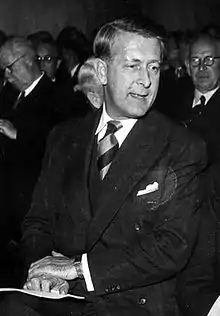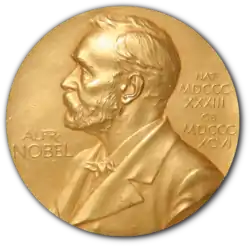Bertil Ohlin
Bertil Gotthard Ohlin (Swedish: [ˈbæ̌ʈːɪl ʊˈliːn]) (23 April 1899 – 3 August 1979) was a Swedish economist and politician. He was a professor of economics at the Stockholm School of Economics from 1929 to 1965. He was also leader of the People's Party, a social-liberal party which at the time was the largest party in opposition to the governing Social Democratic Party, from 1944 to 1967. He served briefly as Minister for Trade from 1944 to 1945 in the Swedish coalition government during World War II. He was President of the Nordic Council in 1959 and 1964.
Bertil Ohlin | |
|---|---|
 Bertil Ohlin | |
| Minister for Trade | |
| In office 1944–1945 | |
| Prime Minister | Per Albin Hansson |
| Preceded by | Herman Eriksson |
| Succeeded by | Gunnar Myrdal |
| Leader of the People's Party | |
| In office 1944–1967 | |
| Preceded by | Gustaf Andersson |
| Succeeded by | Sven Wedén |
| Member of the Swedish Parliament for Stockholm Municipality | |
| In office 1938–1970 | |
| President of the Nordic Council | |
| In office 1959–1959 | |
| Preceded by | Nils Hønsvald |
| Succeeded by | Gísli Jónsson |
| In office 1964–1964 | |
| Preceded by | Nils Hønsvald |
| Succeeded by | Sigurður Bjarnason |
| Personal details | |
| Born | 23 April 1899 Klippan, Sweden |
| Died | 3 August 1979 (aged 80) Åre, Sweden |
| Nationality | Sweden |
| Political party | People's Party |
| Alma mater | B.A. Lund University (1917) MSc. Stockholm School of Economics (1919) M.A. Harvard University (1923) PhD Stockholm University (1924) |
Bertil Ohlin | |
|---|---|
| Known for | Heckscher–Ohlin model Heckscher–Ohlin theorem |
| Awards | Nobel Memorial Prize in Economic Sciences (1977) |
| Scientific career | |
| Fields | Economics |
| Institutions | University of Copenhagen (1925–1930) Stockholm School of Economics (1930–1965) |
| Doctoral advisor | Gustav Cassel |
Ohlin's name lives on in one of the standard mathematical models of international free trade, the Heckscher–Ohlin model, which he developed together with Eli Heckscher. He was jointly awarded the Nobel Memorial Prize in Economic Sciences in 1977 together with the British economist James Meade "for their pathbreaking contribution to the theory of international trade and international capital movements".
Biography
Having received his B.A. from Lund University 1917 and his MSc. from Stockholm School of Economics in 1919. He obtained an M.A. from Harvard University in 1923 and his doctorate from Stockholm University in 1924. In 1925 he became a professor at the University of Copenhagen. In 1929 he debated with John Maynard Keynes, contradicting the latter's view on the consequences of the heavy war reparations payments imposed on Germany. (Keynes predicted a war caused by the burden of debt, Ohlin thought that Germany could afford the reparations.) The debate was important in the modern theory of unilateral international payments.
In 1930 Ohlin succeeded Eli Heckscher, his teacher, as a professor of economics, at the Stockholm School of Economics. In 1933 Ohlin published a work that made him world-renowned, Interregional and International Trade. In this Ohlin built an economic theory of international trade from earlier work by Heckscher and his own doctoral thesis. It is now known as the Heckscher–Ohlin model, one of the standard model economists use to debate trade theory.
The model was a break-through because it showed how comparative advantage might relate to general features of a country's capital and labor, and how these features might change through time. The model provided a basis for later work on the effects of protection on real wages, and has been fruitful in producing predictions and analysis; Ohlin himself used the model to derive the Heckscher–Ohlin theorem, that nations would specialize in industries most able to utilize their mix of national resources efficiently. Today, the theory has been largely disproved, yet it is still a useful framework by which to understand international trade.
In 1937, Ohlin spent half a year at the University of California, Berkeley, as a visiting professor.[1][2][3]
Later, Ohlin and other members of the "Stockholm school" extended Knut Wicksell's economic analysis to produce a theory of the macroeconomy anticipating Keynesianism.
Ohlin was party leader of the liberal Liberal People's Party from 1944 to 1967, the main opposition party to the Social Democrat Governments of the era, and from '44 to '45 was minister of commerce in the wartime government. His daughter Anne Wibble, representing the same party, served as Minister of Finance from 1991 to 1994.
In 2009, a street adjacent to the Stockholm School of Economics was named after Ohlin: "Bertil Ohlins Gata".
Heckscher–Ohlin theorem
The Heckscher–Ohlin Theorem, which is concluded from the Heckscher–Ohlin model of international trade, states: trade between countries is in proportion to their relative amounts of capital and labor. In countries with an abundance of capital, wage rates tend to be high; therefore, labor-intensive products, e.g. textiles, simple electronics, etc., are more costly to produce internally. In contrast, capital-intensive products, e.g. automobiles, chemicals, etc., are less costly to produce internally. Countries with large amounts of capital will export capital-intensive products and import labor-intensive products with the proceeds. Countries with high amounts of labor will do the reverse.
The following conditions must be true:
- The major factors of production, namely labor and capital, are not available in the same proportion in both countries.
- The two goods produced either require more capital or more labor.
- Labor and capital do not move between the two countries.
- There are no costs associated with transporting the goods between countries.
- The citizens of the two trading countries have the same needs.
The theory does not depend on total amounts of capital or labor, but on the amounts per worker. This allows small countries to trade with large countries by specializing in production of products that use the factors which are more available than its trading partner. The key assumption is that capital and labor are not available in the same proportions in the two countries. That leads to specialization, which in turn benefits the country's economic welfare. The greater the difference between the two countries, the greater the gain from specialization.
Wassily Leontief made a study of the theory that seemed to invalidate it. He noted that the United States had a lot of capital; therefore, it should export capital-intensive products and import labor-intensive products. Instead, he found that it exported products that used more labor than the products it imported. This finding is known as the Leontief paradox.
See also
Significant publications

- The German Reparations Problem, 1930
- The Cause and Phases of the World Economic Depression. Report presented to the Assembly of the League of Nations Geneva: Secretariat of the League of Nations; 1931.
- Interregional and International Trade, 1933
- Mechanisms and Objectives of Exchange Controls, 1937
Sources
References
- "BERTH OHLIN'S CONTRIBUTIONS TO ECONOMIC THEORY" (PDF).
- Findlay, Ronald; Jonung, Lars; Lundahl, Mats (2002). Bertil Ohlin: A Centennial Celebration, 1899–1999. MIT Press. ISBN 9780262062282.
- Toporowski, J. (29 July 2013). Michał Kalecki: An Intellectual Biography: Volume I Rendezvous in Cambridge 1899–1939. Springer. ISBN 9781137315397.
Further reading
- John Cunningham Wood (1995). Bertil Ohlin: Critical Assessments. Routledge. ISBN 978-0-415-07492-6.
External links
| Wikiquote has quotations related to: Bertil Ohlin |
- Bertil Ohlin on Nobelprize.org
 including the Prize Lecture on December 8, 1977 1933 and 1977 – Some Expansion Policy Problems in Cases of Unbalanced Domestic and International Economic Relations
including the Prize Lecture on December 8, 1977 1933 and 1977 – Some Expansion Policy Problems in Cases of Unbalanced Domestic and International Economic Relations - Bertil Ohlin
- Bertil Ohlin Institute
- Ohlin's life
- Academician RACEF, Spain
- Presentation: THE YOUNG OHLIN ON THE THEORY OF INTERREGIONAL AND INTERNATIONAL TRADE
- IDEAS/RePEc
- Bertil Gotthard Ohlin (1899–1979). The Concise Encyclopedia of Economics. Library of Economics and Liberty (2nd ed.). Liberty Fund. 2008.
- Newspaper clippings about Bertil Ohlin in the 20th Century Press Archives of the ZBW

| Party political offices | ||
|---|---|---|
| Preceded by Gustaf Andersson |
Chairman of the People's Party 1944–1967 |
Succeeded by Sven Wedén |
| Political offices | ||
| Preceded by Herman Eriksson |
Minister for Trade 1944–1945 |
Succeeded by Gunnar Myrdal |
| Awards | ||
| Preceded by Milton Friedman |
Laureate of the Nobel Memorial Prize in Economics 1977 Served alongside: James E. Meade |
Succeeded by Herbert A. Simon |

